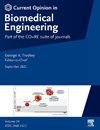多孔微针:生物医学设备工程的透皮盐桥
IF 4.2
3区 工程技术
Q2 ENGINEERING, BIOMEDICAL
引用次数: 0
摘要
微针(MNs)是一种有吸引力的选择,作为一种微创手段,突破皮肤角质层进行透皮给药和间质液分析。固体基多孔微针(PMN)是一种新型的微纳米通道网络。充满电解质溶液的PMN充当“盐桥”,在皮肤表层建立离子通道。本文从生物医学工程的角度综述了离子导电PMN的优点。在简要介绍了PMN的制备技术后,定量地讨论了PMN插入对透皮阻力的降低。此外,还介绍了pmn盐桥的潜在应用,包括皮肤电位和电阻测量、皮内电化学分析和透皮分子运输。本文章由计算机程序翻译,如有差异,请以英文原文为准。
Porous microneedles: Transdermal salt bridge for biomedical device engineering
Microneedles (MNs) are an attractive option as a minimally invasive means to break through the stratum corneum of the skin for transdermal drug delivery and the analysis of interstitial fluid. The solid-based porous microneedle (PMN) is a relatively new type of MN with a micro/nanochannel network throughout the whole needle. The PMN, filled with an electrolyte solution serves as a ‘salt bridge’ to create an ionic pathway across the skin surface layer. This review outlines the advantages of the ionically conductive PMN from a biomedical engineering perspective. After a brief description of the fabrication techniques of PMN, the decrease in transdermal resistance by PMN insertion is quantitatively discussed. In addition, possible applications of PMN-based salt bridges are presented, including the skin potential and resistance measurements, intradermal electrochemical analysis, and transdermal molecular transport.
求助全文
通过发布文献求助,成功后即可免费获取论文全文。
去求助
来源期刊

Current Opinion in Biomedical Engineering
Medicine-Medicine (miscellaneous)
CiteScore
8.60
自引率
2.60%
发文量
59
 求助内容:
求助内容: 应助结果提醒方式:
应助结果提醒方式:


